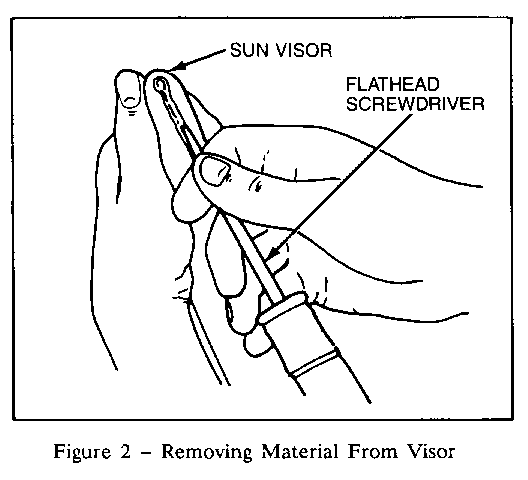SUNVISOR TO MAP LIGHT HOUSING INTERFERENCE

SUBJECT: SUN VISOR TO MAP LIGHT HOUSING INTERFERENCE AND/OR IMPROVED SUN VISOR RETENTION - (PAIR PROCEDURE)
VEHICLES AFFECTED: 1989 CADILLAC "C"
Some 1989 DeVilles and Fleetwoods may experience a condition where the sun visors may rub or interfere with the map light housing and/or the sun visor may "rollout" from the map light housing jaw when cycling up and down.
To improve sun visor interference use the following procedure:
1. Remove visor from car at A-Pillar. Disconnect visor hot-lead from body harness. Refer to Figure 1.
2. Set visor on clean and protected work surface.
3. Remove rubber roller tip from tip pin.
4. Grasp tip pin firmly with pliers while holding visor, wiggle tip pin to loosen, and pull tip pin out.
IMPORTANT: Grasp tip pin in rubber tip area to prevent scratching tip pin body.
5. Using hot air gun on medium setting, warm nose area of visor directing air toward seam on visor tip pin area. Watch fabric for signs of discoloration or melting. Stop immediately at first signs of discoloration or melting.
6. Using a flat-head screwdriver untuck fabric along entire tip pin edge, refer to Figure 2.
7. Pull fabric back to expose approximately 1/2 inch of plastic core.
8. Measure 3-4mm from inboard edge of visor and cut this amount off with a band saw or hacksaw, refer to Figure 3.
9. File all edges including tip pin hole.
10. Trim excess fabric material while leaving enough to tuck back into seam, approximately 3-4mm.
11. Stretch fabric over plastic core and tuck into seam with flat -head screwdriver.
12. Push remaining fabric into tip pin hole.
13. Reinsert tip pin by firmly pushing into tip pin hole.
14. Install rubber roller tip.
To improve sun visor retention at the map light housing jaw use the following procedure:
1. Loosen three sun visor retaining screws and remove outboard screw.
2. At outboard screw, place a 1/8 inch thick washer or shim.
3. Tighten sun visor retaining screws.
4. If visor is still angled downward, add another shim using steps 1 through 3.
Use most applicable Labour operation and Time from the Canadian Labour Time Guide.



General Motors bulletins are intended for use by professional technicians, not a "do-it-yourselfer". They are written to inform those technicians of conditions that may occur on some vehicles, or to provide information that could assist in the proper service of a vehicle. Properly trained technicians have the equipment, tools, safety instructions and know-how to do a job properly and safely. If a condition is described, do not assume that the bulletin applies to your vehicle, or that your vehicle will have that condition. See a General Motors dealer servicing your brand of General Motors vehicle for information on whether your vehicle may benefit from the information.
